| Home»China's Massive Earthquake» The Wenchuan Earthquake |
The Wenchuan Earthquake
The date of the earthquake is May 12, 2008. This corresponds to the Hebrew date of the 7th of Iyar. The month Iyar has two possible spellings: with a single Yod or two Yods: איר and אייר. Following our standard protocol, there are three forms for the date: Iyar 7, 7th of Iyar, on Iyar 7. Thus there are 6 subexperiments in which we group a date key word with the key words Wenchuan, earth quake. None of these 6 subexperiments produced a statistically significant result. Then we tried using the key word pair Wen and Chuan. in place of the key word Wenchuan. Here also, none of the 6 subexperiments produced a statistically significant result. The best table of these 6 subexperiments used the date key word 7th of Iyar with Iyar spelled with the double Yod. With expected number of ELSs set to 50, the probability that a text from the ELS random placement text population would have as compact a table as that produced by the Torah text is 108/1,000.
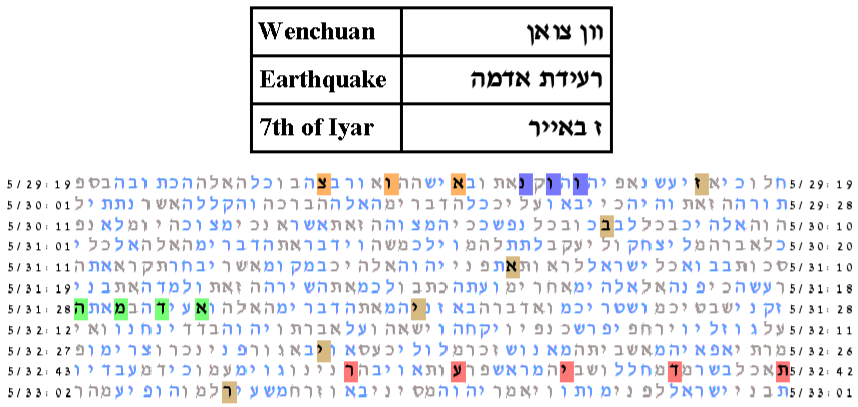
There is perhaps an interesting development of this table. First the table contains an ELS for our secondary phrase for earthquake. It has the phrase: earthquake destroyed houses. And it has an ELS for the word destruction in plural form and an ELS for the key word to die.
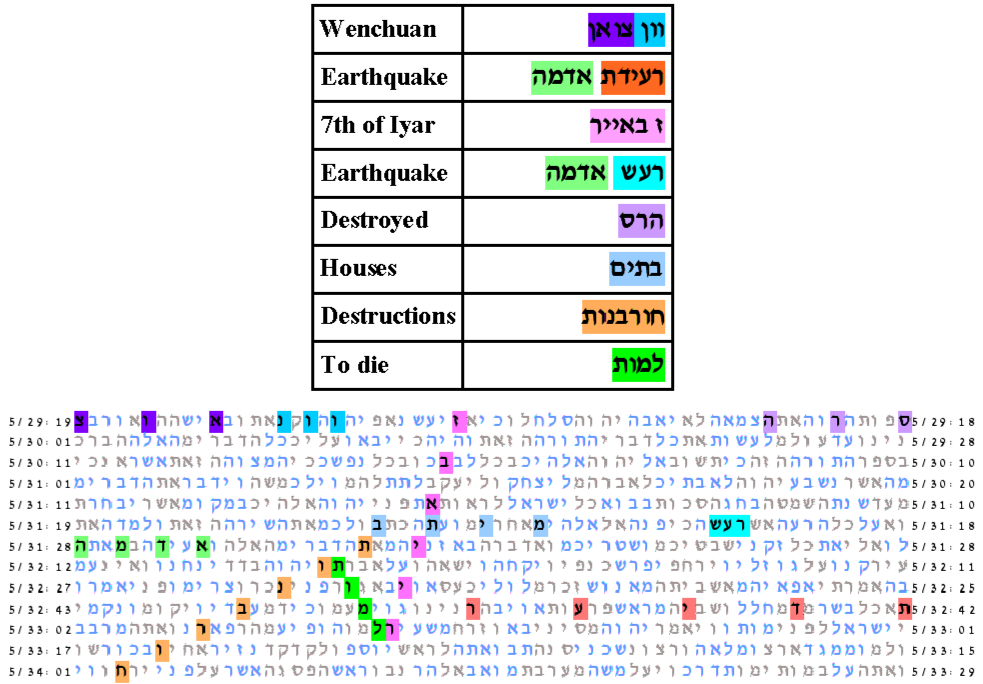
The table also has two relevant verses. These are shown in the table below. The top row of the table has the portion of the verse For then God's anger and jealouy will kindle against that man. Running through the middle of the table is a verse Because it (actually meaning they, referring to the Israelites) turned to other gods.
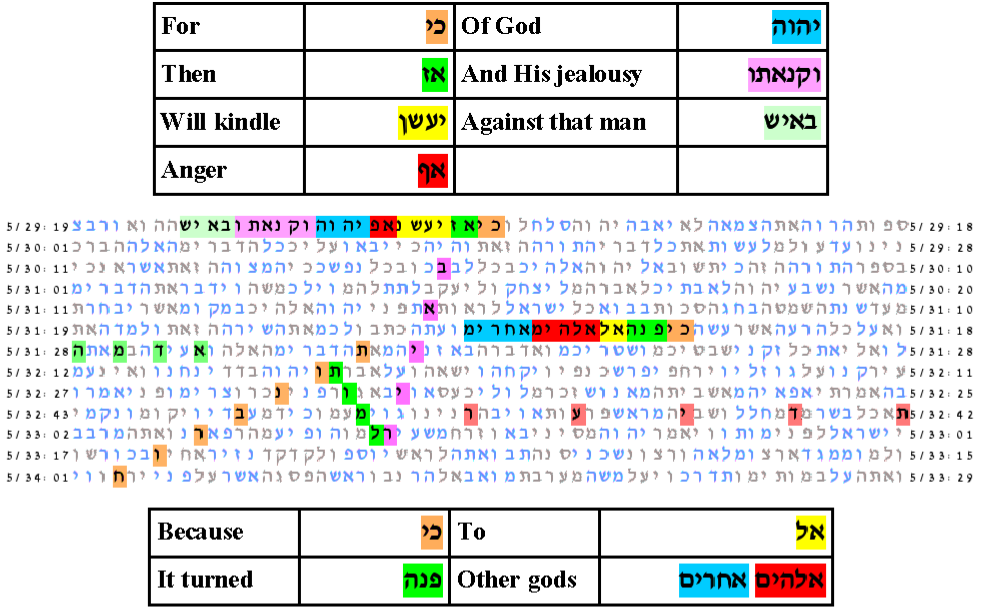
The Sichuan province of China is mainly populated by people called in China as ethnic minorities. These minorities include the Lisu and Miao, whose religion is polytheism, the Naxi, whose religion is Dongba and Lamais,, the Qiang, whose religion is Animism, and the Tibetans, whose religion is Lamaism. The Qiang minority live in small mountain towns, many of which are remote. Almost all were situated within 100 miles of the earthquake's epicenter, some right on the fault zone of the Wenchuan earthquake. The number of Qiang minority is small, only 300,000 and the Wenchuan earthquake was particularly devasting for them. They traditionally marry only within their group and celebrate their new year on a lunar calendar around October 1. It has been suggested that they may have some relationship to one of the lost tribes of Israel.
The date May 12, 2008 corresponds to the Hebrew year of 5768. We try for the year key word two forms: 5768 and the shortened form 768. We use the two appellations for Wenchuan. Our experiment has, therefore, 4 subexperiments. four subexperiments. None of the subexperiments produced a statistically significant result. For the best subexperiment, with expected number of ELSs set to 50, the probability that a text from the ELS random placement text population would produce a table as compact as that produced by the Torah text is 191/1,000.
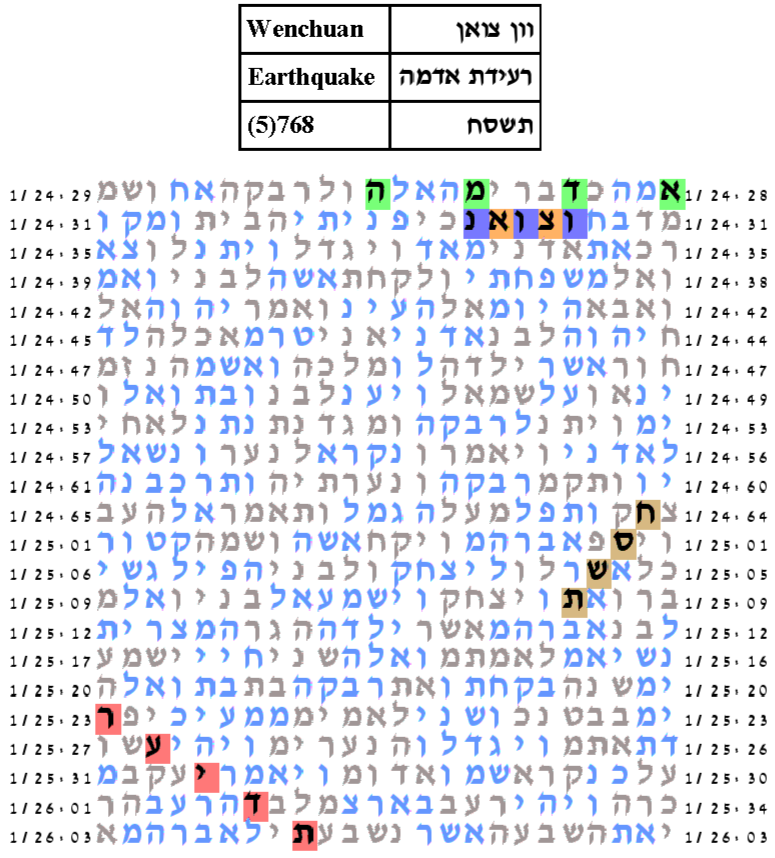
Other than the first experiment with the key words Wenchuan, Earth, and Quake, none of the remaining experiments produced statistically significant results. This means either that the date and year is not encoded or that it is encoded but there are additional key words that we must use in the experiment. It strikes us as odd that the date should not be encoded. Therefore, in the next search we will try a few more experiments in which we use some additional relevant key words.
The earthquake affected most strongly two counties: Wenchuan, Beichuan. The name Beichuan, like Wenchuan, is likewise a two Chinese character name. The first character Bei means north and the second character Chuan means river. We add Beichuan as key word. As Wenchuan was found in its best table with the date and the year in the two key word appellation form, so we use Beichuan in the two word appellation form. The best result for the date used the form 7 Iyar. With expected number of ELSs set to 75, the probability that a text from the ELS random placement text population would have as compact a table as that produced by the Torah text is 21.5/200.
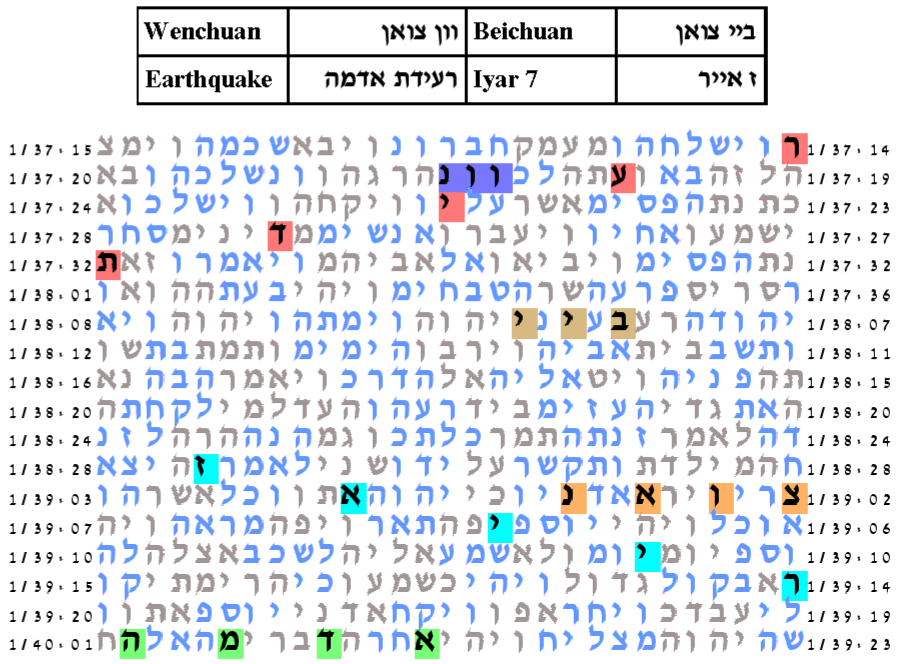
The best result for the year used the form 5768. With expected number of ELSs set to 75, the probability that a text from the ELS random placement text population would have as compact a table as that produced by the Torah text is 4.5/200.

The experimental results have not been as strong as what we would have expected given that there is an encoding. Perhaps we still do not have the description that in fact is encoded. We try another experiment adding the key word China. The best result for the date was with the date form 7th of Iyar spelled with the double Yod. And the best table is in a different place from the previous tables of dates. With expected number of ELSs set to 75, the probability that a text from the ELS random placement text population would produce a table as compact as that produced by the Torah text is 41.5/1,000.

Proceeding in a similar way, we add the key word China to the key words used in the experiment having the year. The best result for the year was with 5768. This table is in the same location as the very first table we showed with the year. With expected number of ELSs set to 75, the probability that a text from the ELS random placement text population would produce a table as compact as that produced by the Torah text is 21.5/1,000.


 Documentaries and Tutorials
Documentaries and Tutorials